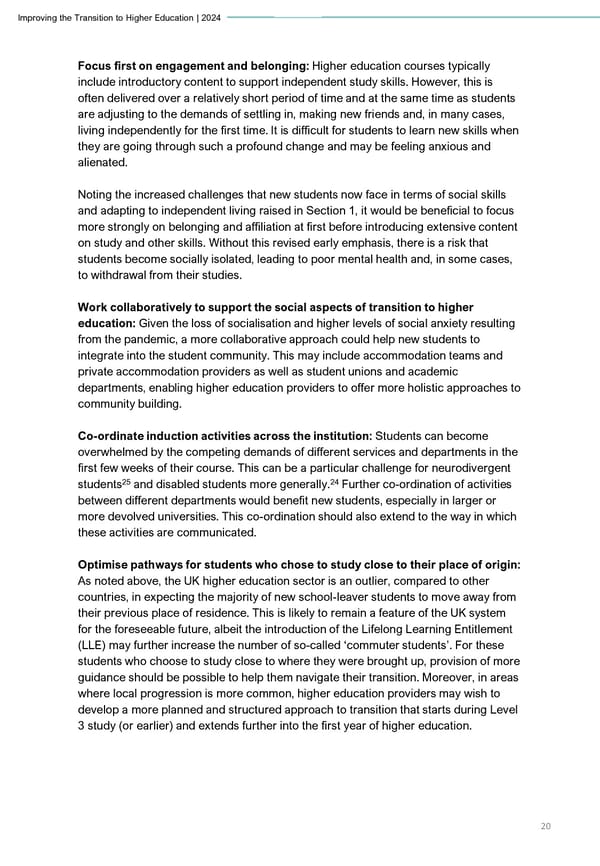Improving the Transition to Higher Education | 2024 Internal Focus first on engagement and belonging: Higher education courses typically include introductory content to support independent study skills. However, this is often delivered over a relatively short period of time and at the same time as students are adjusting to the demands of settling in, making new friends and, in many cases, living independently for the first time. It is difficult for students to learn new skills when they are going through such a profound change and may be feeling anxious and alienated. Noting the increased challenges that new students now face in terms of social skills and adapting to independent living raised in Section 1, it would be beneficial to focus more strongly on belonging and affiliation at first before introducing extensive content on study and other skills. Without this revised early emphasis, there is a risk that students become socially isolated, leading to poor mental health and, in some cases, to withdrawal from their studies. Work collaboratively to support the social aspects of transition to higher education: Given the loss of socialisation and higher levels of social anxiety resulting from the pandemic, a more collaborative approach could help new students to integrate into the student community. This may include accommodation teams and private accommodation providers as well as student unions and academic departments, enabling higher education providers to offer more holistic approaches to community building. Co-ordinate induction activities across the institution: Students can become overwhelmed by the competing demands of different services and departments in the first few weeks of their course. This can be a particular challenge for neurodivergent 25 24 students and disabled students more generally. Further co-ordination of activities between different departments would benefit new students, especially in larger or more devolved universities. This co-ordination should also extend to the way in which these activities are communicated. Optimise pathways for students who chose to study close to their place of origin: As noted above, the UK higher education sector is an outlier, compared to other countries, in expecting the majority of new school-leaver students to move away from their previous place of residence. This is likely to remain a feature of the UK system for the foreseeable future, albeit the introduction of the Lifelong Learning Entitlement (LLE) may further increase the number of so-called 8commuter students9. For these students who choose to study close to where they were brought up, provision of more guidance should be possible to help them navigate their transition. Moreover, in areas where local progression is more common, higher education providers may wish to develop a more planned and structured approach to transition that starts during Level 3 study (or earlier) and extends further into the first year of higher education. 20
 Improving the transition to Higher Education Page 19 Page 21
Improving the transition to Higher Education Page 19 Page 21